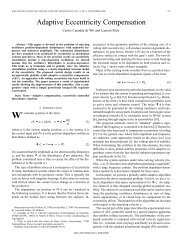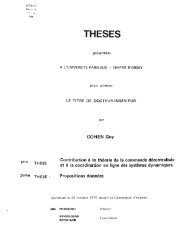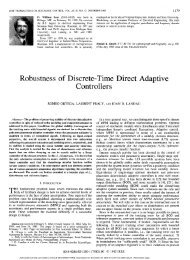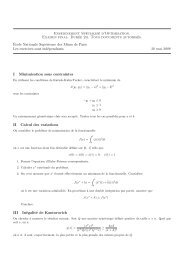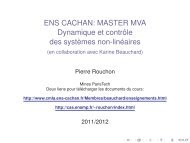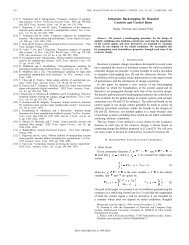Copyright © by SIAM. Unauthorized reproduction of this article is ...
Copyright © by SIAM. Unauthorized reproduction of this article is ...
Copyright © by SIAM. Unauthorized reproduction of this article is ...
Create successful ePaper yourself
Turn your PDF publications into a flip-book with our unique Google optimized e-Paper software.
HOMOGENEOUS OBSERVER DESIGN 1849[4] S. P. Bhat and D. S. Bernstein, Finite-time stability <strong>of</strong> continuous autonomous systems,<strong>SIAM</strong> J. Control Optim., 38 (2000), pp. 751–766.[5] J.-M. Coron and L. Praly, Adding an integrator for the stabilization problem, Systems ControlLett., 17 (1991), pp. 89–104.[6] J.-M. Coron and L. Rosier, A relation between continuous time-varying and d<strong>is</strong>continuousfeedback stabilization, J. Math. Systems Estim. Control, 4 (1994), pp. 67–84.[7] J. P. Gauthier and I. Kupka, Determin<strong>is</strong>tic Observation Theory And Applications, CambridgeUniversity Press, Cambridge, UK, 2001.[8] W. Hahn, Stability <strong>of</strong> Motion, Springer-Verlag, Berlin, 1967.[9] H. Hermes, Homogeneous coordinates and continuous asymptotically stabilizing feedback controls,in Differential Equations: Stability and Control, Lecture Notes in Pure Appl.Math. 109, S. Elaydi, ed., Marcel Dekker, New York, 1991, pp. 249–260.[10] Y. Hong, Finite-time stabilization and stabilizability <strong>of</strong> a class <strong>of</strong> controllable systems, SystemsControl Lett., 46 (2002), pp. 231–236.[11] Z.-P. Jiang, A. Teel, and L. Praly, Small-gain theorem for ISS systems and applications,Math. Control Signals Systems, 7 (1994), pp. 95–120.[12] M. Kawski, Stabilization <strong>of</strong> nonlinear systems in the plane, Systems Control Lett., 12 (1989),pp. 169–175.[13] H. Khalil and A. Saberi, Adaptive stabilization <strong>of</strong> a class <strong>of</strong> nonlinear systems using highgainfeedback, IEEE Trans. Automat. Control, 32 (1987), pp. 1031–1035.[14] S. Lefschetz, Differential Equations: Geometric Theory, 2nd ed., Dover, New York, 1977.[15] W. Liu, Y. Chitour, and E. Sontag, On finite-gain stabilizability <strong>of</strong> linear systems subjectto input saturation, <strong>SIAM</strong> J. Control Optim., 34 (1996), pp. 1190–1219.[16] J. L. Massera, Contributions to stability theory, Ann. <strong>of</strong> Math., 64 (1956), pp. 182–206.[17] F. Mazenc, Stabil<strong>is</strong>ation de trajectoires, ajout d’intégration, commandes saturées, Mémoirede thèse en Mathématiques et Automatique de l’École Nationale Supérieure des Mines dePar<strong>is</strong>, Avril 1996.[18] F. Mazenc, L. Praly, and W. P. Dayawansa, Global stabilization <strong>by</strong> output feedback: Examplesand counter-examples, Systems Control Lett., 23 (1994), pp. 119–125.[19] P. Morin and C. Samson, Application <strong>of</strong> backstepping techniques to the time-varying exponentialstabil<strong>is</strong>ation <strong>of</strong> chained form systems, European J. Control, 3 (1997), pp. 15–36.[20] R. Orsi, L. Praly, and I. Mareels, Sufficient conditions for the ex<strong>is</strong>tence <strong>of</strong> an unboundedsolution, Automatica, 37 (2001), pp. 1609–1617.[21] L. Praly, B. d’Andréa-Novel, and J.-M. Coron, Lyapunov design <strong>of</strong> stabilizing controllersfor cascaded systems, IEEE Trans. Automat. Control, 36 (1991), pp. 1177–1181.[22] L. Praly and Z.-P. Jiang, Stabilization <strong>by</strong> output feedback for systems with ISS inversedynamics, Systems Control Lett., 21 (1993), pp. 19–33.[23] L. Praly and Z.-P. Jiang, Further results on robust semiglobal stabilization with dynamicinput uncertainties, in Proceedings <strong>of</strong> the 37th Annual IEEE Conference on Dec<strong>is</strong>ion andControl, Tampa, 1998, pp. 891–896.[24] L. Praly and Z.-P. Jiang, Linear output feedback with dynamic high gain for nonlinearsystems, Systems Control Lett., 53 (2004), pp. 107–116.[25] L. Praly and F. Mazenc, Design <strong>of</strong> Homogeneous Feedbacks for a Chain <strong>of</strong> Integrators andApplications, Internal report E 173, CAS, Ecole des Mines de Par<strong>is</strong>, Par<strong>is</strong>, December 11,1995; rev<strong>is</strong>ed April 15, 1996.[26] C. Qian, A homogeneous domination approach for global output feedback stabilization <strong>of</strong> a class<strong>of</strong> nonlinear systems, in Proceedings <strong>of</strong> the IEEE American Control Conference, Portland,2005, pp. 4708–4715.[27] C. Qian and W. Lin, Output feedback control <strong>of</strong> a class <strong>of</strong> nonlinear systems: A nonseparationprinciple paradigm, IEEE Trans. Automat. Control, 47 (2002), pp. 1710–1715.[28] C. Qian and W. Lin, Recursive observer design, homogeneous approximation, and nonsmoothoutput feedback stabilization <strong>of</strong> nonlinear systems, IEEE Trans. Automat. Control, 51(2006), pp. 1457–1471.[29] L. Rosier, Homogeneous Lyapunov function for homogeneous continuous vector field, SystemsControl Lett., 19 (1992), pp. 467–473.[30] H. Shim and J. Seo, Recursive nonlinear observer design: Beyond the uniform observability,IEEE Trans. Automat. Control, 48 (2003), pp. 294–298.[31] E. D. Sontag, Input to state stability: Basic concepts and results, in Nonlinear and OptimalControl Theory, P. N<strong>is</strong>tri and G. Stefani, eds., Springer-Verlag, Berlin, 2006, pp. 163–220.[32] E. Sontag and Y. Wang, Lyapunov characterizations <strong>of</strong> input to output stability, <strong>SIAM</strong> J.Control Optim., 39 (2000), pp. 226–249.<strong>Copyright</strong> © <strong>by</strong> <strong>SIAM</strong>. <strong>Unauthorized</strong> <strong>reproduction</strong> <strong>of</strong> <strong>th<strong>is</strong></strong> <strong>article</strong> <strong>is</strong> prohibited.




